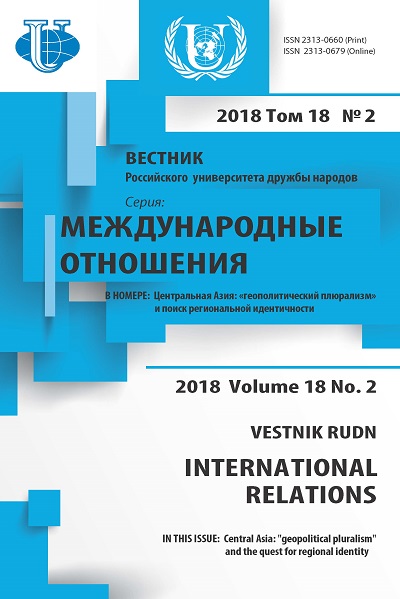EU HUMANITARIAN ACTIVITIES IN THE CENTRAL ASIAN COUNTRIES OF THE POST-SOVIET SPACE: CHALLENGES AND OPPORTUNITIES FOR RUSSIA
- Authors: Rustamova L.R.1,2
-
Affiliations:
- Moscow State Institute of International Relations (MGIMO-University)
- Primakov Institute of World Economy and International Relations of the Russian Academy of Sciences (IMEMO)
- Issue: Vol 18, No 2 (2018): Central Asia: “geopolitical pluralism” and the quest for regional identity
- Pages: 304-314
- Section: THEMATIC DOSSIER
- URL: https://journals.rudn.ru/international-relations/article/view/18882
- DOI: https://doi.org/10.22363/2313-0660-2018-18-2-304-314
Cite item
Full Text
Abstract
In connection with the growing security threats related to migration flows from the troubled regions of the world and the need to diversify transport flows of hydrocarbon resources, the EU began to pay attention to the cooperation with the Central Asian countries. Within the framework of the EU Strategy for Central Asia, several priority areas were adopted, according to which it was planned to build relations with the post-Soviet republics most closely. This study aims to analyze the main projects in the field of humanitarian cooperation between the EU and the Central Asian countries and to establish to what extent such projects are competitive in comparison with the Russian ones, as the countries of the region belong to the area of Russian interests. To achieve this goal the author used general scientific methods and systematic approach. While analyzing the documents which give the theoretical explanation of the importance of the region for European partners and materials of foreign and Russian researchers devoted to the humanitarian problems of the region and the main results of the EU Strategy for Central Asia, the author comes to the conclusion that the projects of humanitarian cooperation of the EU with the countries of Central Asia do not take into account the national characteristics and priority needs of the former Soviet republics. However, many projects are quite competitive in comparison with the Russian ones and in order to stay as a strategic partner in the long-term future for the countries of the region Russia needs to take into account their best characteristics and achievements.
About the authors
Leili Rustamovna Rustamova
Moscow State Institute of International Relations (MGIMO-University); Primakov Institute of World Economy and International Relations of the Russian Academy of Sciences (IMEMO)
Author for correspondence.
Email: leili-rustamova@yandex.ru
PhD in Political Science, Assistant Lecturer at the World Politics Department, expert of PhD and postgraduate study Department of Moscow State Institute of International Relations (MGIMO-University); Researcher of the Primakov National Research Institute of World Economy and International Relations (IMEMO)
References
- Chebotarev, A.E. (Ed.) (2013). Strategy of the European Union in Central Asia for 2007—2013: preliminary results: Monograph. Almaty: Center for Topical Studies “Alternative”; Center for German Studies KazNU. al-Farabi; The Foundation. Friedrich Ebert in Kazakhstan. (In Russ.).
- Cordier, B. EU humanitarian assistance and civil protection in Central Asia: past and future crises. URL: http://www.eucentralasia.eu/uploads/tx_icticontent/EUCAM-PB-29-Humanitarian-aidRU_01.pdf (accessed: 12.12.2017). (In Russ.).
- Kassenova, N. (2007). The EU in Central Asia: strategy in the context of Eurasian geopolitics. Central Asia and the Caucasus, 4, 99—108. (In Russ.).
- Likhacheva, A.B. (2014). EU-Russia Relations Regarding Water Resources in Central Asia. International Organizations Research Journal, 9(3), 47—67. (In Russ.).
- Luk'yanov, G. (2017). Kyrgyzstan: “island of democracy” before the challenge of effective governance. Russian International Affairs Council. URL: http://russiancouncil.ru/analytics-and-comments/ analytics/kyrgyzstan-ostrov-demokratii-pered-vyzovom-effektivnogo-upravleniya/ (accessed: 12.12.2017). (In Russ.).
- Mikhaylina, I. (2014). Humanitarian projects in Germany: from Ebola fever to unexploded mines. Germany-online.ru. URL: http://www.germania-online.diplo.de/Vertretung/russland-dz/ru/01politik/aussenpolitik/humanitaere-projekte-des-aa.html (accessed: 12.12.2017). (In Russ.).
- Paramonov, V.V., Strokov A.V., Abduganiva Z.A. The impact of the European Union on Central Asia: review, analysis and forecast. Almaty: The Friedrich Ebert Foundation, 2017. 117 s. (In Russ.).
- Rustamova, L.R. (2016). “Soft power” in the foreign policy of modern Germany. [dissertation]. Moscow. (In Russ.).
- Soloviev, E.G. (2011). Humanitarian dimension of “soft power”: “human security” in the foreign policy of the Russian Federation. International Life, 8, 47—60. (In Russ.).
- Strezhneva, M.V. & Rudenkova, D.E. (2016). The European Union: the architecture of foreign policy. Moscow: IMEMO RAS. (In Russ.).
- Zonova, T. (2013). Humanitarian cooperation between Russia and the European Union as an instrument of “soft power”. Russian International Affairs Council. URL: http://russiancouncil.ru/ analytics-and-comments/analytics/gumanitarnoe-sotrudnichestvo-rossii-i-evropeyskogo-soyuza-ka/ (accessed: 12.12.2017). (In Russ.).
- Fedya, I.V. & Mezhelovskaya, M.O. (2017). Methodological and theoretical foundations of the humanitarian dimension of foreign policy. Vestnik KRSU, 17(4), 87—90. (In Russ.).
- Perrin, P. (1998). The Impact of humanitarian aid on conflict development. International Review of the Red Cross. № 323. URL: http://www.icrc.org/eng/resources/documents/misc/57jpcj.htm (accessed: 12.12.2017).
- Stern, P.C. & Druckman, D. (2000). New Challenges to Conflict Resolution: Humanitarian Nongovernmental Organizations in Complex Emergencies. In: International Conflict Resolution After the Cold War. National Research Council. Washington, DC: The National Academies Press. doi: 10.17226/9897.











